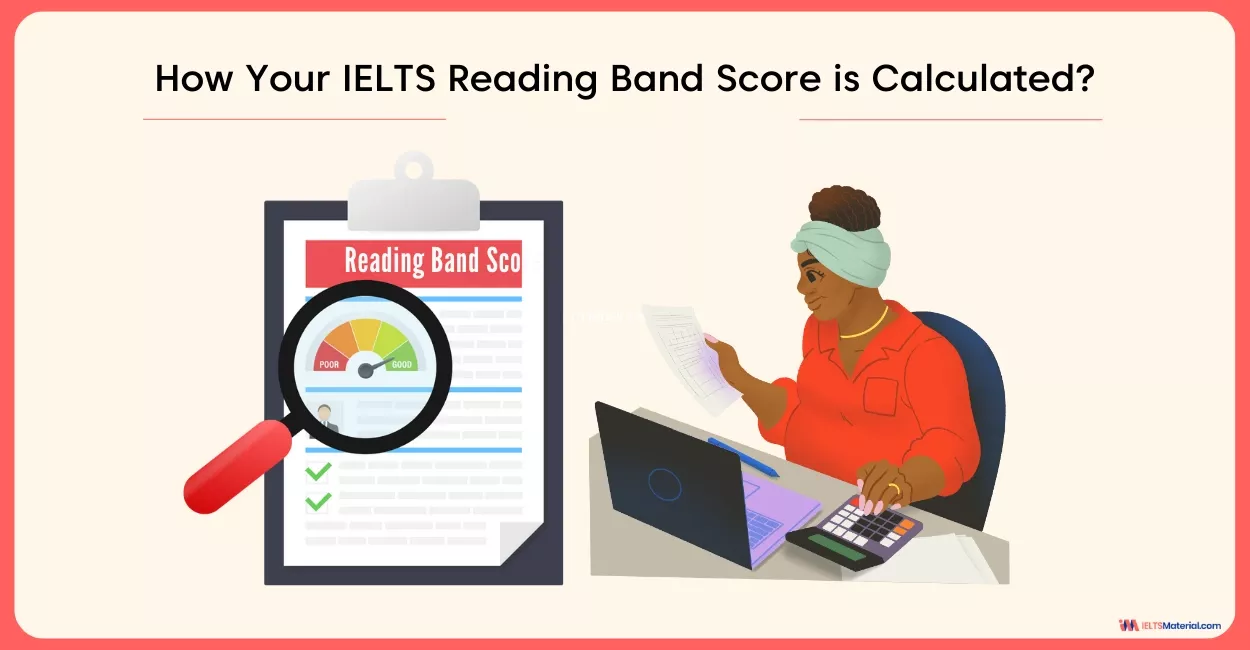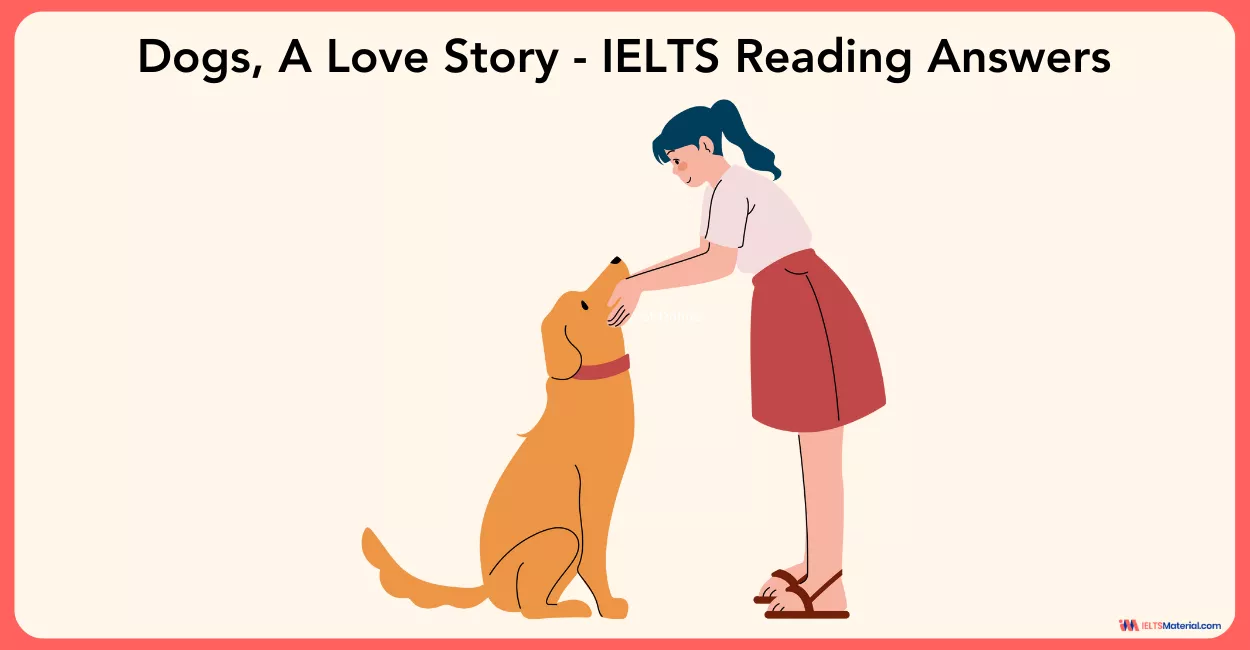Dogs, A Love Story - IELTS Reading Answers
12 min read
Updated On
-
Copy link
The Academic passage ‘Dogs, A Love Story’ appeared in an IELTS Reading test. This blog provides complete answers with detailed explanations, exact answer locations, and expert tips to help you confidently tackle every IELTS Reading question type.
Table of Contents

Limited-Time Offer : Access a FREE 10-Day IELTS Study Plan!
The Academic passage ‘Dogs, A Love Story - IELTS Reading Answers’ is a challenging IELTS Reading passage that appeared in the test, designed to assess your comprehension and analytical skills. In this blog, you’ll find the complete IELTS Reading answers with detailed explanations, exact answer locations in the passage, and step-by-step reasoning. We also provide expert IELTS Reading tips and strategies to help you confidently tackle every question type and improve your overall band score.
Dogs, A Love Story - IELTS Reading Passage
You should spend about 20 minutes on Questions 1 - 13, which are based on the Reading Passage below.
- Genetic studies demonstrate that dogs evolved through wolves and are as identical to the creatures from which they descended as humans with various physical attributes are to each other, i.e. not very dissimilar. 'Even in the most changeable mitochondrial DNA markers — DNA passed down from mother to child — dogs and wolves differ by less than 1%,' says Robert Wayne who is a geneticist at the University of California, Los Angeles.
- According to Wayne, wolf-like creatures date back between one and two million years. Genetic research reveals that roughly 100,000 years ago, some kind of dog started to diverge. As early as 400,000 years ago, wolf and early human fossils have been discovered nearby, whereas dog and early human fossils are only about 14,000 years old. This places wolves and/or dogs in the company of man or his ancestors before the advent of agriculture and permanent human settlements, at a time when both species did survive on what they could scrape together through hunting or scavenging.
- Why would these rivals collaborate? The answer most likely rests in the similarities between early human clans and wolf packs in terms of size, social organization, and range of prey, as well as in how openly people welcomed the most docile wolves—those who were young or less aggressive—into their camps.
- After smelling tasty food, some wolves or proto-dogs may have made their way near to the fire ring. They may then have entered early human gatherings by being friendly or helpful. The wolves hung around campsites scavenging leftovers while clans of similarly sized nomadic humans and wandering packs of twenty-five or thirty wolves roamed the landscape simultaneously hunting big game. The humans may have used the wolves' superior scenting abilities and speed to locate and track potential kills. Wolves have acute senses which allow them to alert people to danger at night.
- It's possible that things weren't as difficult back then as is generally believed. In many cases, there would have been plenty of food, few predators, and no clear separation between people and wildlife. Smaller or less dangerous wolves may sneak through those pores, and because they had grown up in packs where alpha bosses presided, they would be familiar with the art of submission and able to adjust to being under the control of humans. Particularly puppies would be difficult to resist in their current state. A domestication process started because of this marriage birth.
- People-friendly breeds that can be distinguished from wolves by their size, shape, coat, ears, and markings have evolved over the course of millennia as a result of the admission of some wolves and proto-dogs into human settlements and the rejection of larger, more menacing ones. Dogs often had smaller snouts than wolves due to their smaller overall size. They would help with the hunt, tidy up the camp by eating trash, warn of danger, keep people warm, and provide food. Puppy eating was a common habit among Native Americans and other people, and it is still common in some cultures.
- Egyptian images on rock and pottery from the fourth millennium BC depict men working with dogs. The partnership had its problems back then, just like it does now. Wild canines prowled the city's streets, robbing shoppers coming home from the market of their food. Dogs continue to appear at all the significant turning points in human history, sometimes in spite of their propensity for misbehaving and other times because of it.
- Aristotle, who lived 350 years before Christ, documented three different breeds of domesticated dogs in ancient Greece, including the swift Laconians that the wealthy used to hunt and kill deer and rabbits. Roman warriors trained huge dogs for combat three hundred years later. An armed man could be dismembered by the brutes once they forced him off his horse.
- Dogs continued to work in seventeenth-century England, herding animals, dragging sleds and plows, hauling carts, or acting as turn-spits to turn beef and venison over open fires. However, working dogs were not well-liked and when they grew old, they were typically hanged or drowned. In the meantime, "unnecessary" dogs rose in status among the English nobility. It was stated that King James I loved his dogs more than any of his subjects. When his ship was lost in a storm in 1682, Charles II's brother Lame had dogs at sea. Charles II was known for playing with his dog at the Council table. He supposedly screamed out, "Save the dogs and Colonel Churchill?" as sailors drowned.
- Private registries were established in the late nineteenth century as a result of the breeding craze to safeguard valuable bloodlines. The English Kennel Club was founded in 1873, while across the Atlantic, the American Kennel Club (AKC) was established eleven years later. The AKC currently recognizes 150 breeds, the Kennel Club 196, and the Fédération Cynologique Internationale, located in Europe, many more. In the middle of the 19th century, as they continue to do today, superfluous dogs began to outnumber working dogs by a significant margin. Unless you consider having a job.
Want to improve your IELTS Academic Reading score? Grab Our IELTS Reading Ebook Today!
Dogs, A Love Story - IELTS Reading Questions
Questions 28-31
28 Which paragraph explains how dogs became different in appearance from wolves?
29 Which paragraph describes the classification of dogs into many different types?
30 Which paragraph states the basic similarity between wolves and dogs?
31 Which paragraph gives examples of greater human concern for animals than for people?
Questions 32-35
A In a typical camp, there were many more wolves than humans.
B Neither the wolves nor the humans lived in one place for long.
C Some wolves learned to obey human leaders,
D Humans chose the most dangerous wolves to help them hunt.
E There was very little for early humans to eat.
F Wolves got food from early humans.
G Wolves started living with humans when agriculture began.
H Early humans especially liked very young wolves.
Questions 36-40
Used by
A the Greeks
B the French
C the Egyptians
D the Romans
E the English
F the Native Americans
36 in war
37 as a source of energy
38 as food
39 to hunt other animals
40 to work with farm animals
Want to boost your IELTS score? Enroll in our expert-led IELTS online classes today!
Dogs, A Love Story - IELTS Reading Answers With Explanation
Let’s now review the answers to the questions from the passage in the reading section, Dogs, A Love Story - IELTS Reading Answers, and assess your improvement for a high IELTS Reading band score.
28 Answer: F
Question type: Matching information
Answer location: Paragraph F, first four lines
Answer explanation: “Over the millennia, admission of certain wolves and proto-dogs into human camps and exclusion of larger, more threatening ones led to the development of people-friendly breeds distinguishable from wolves by size, shape, coat, ears, and markings. Dogs were generally smaller than wolves, their snouts proportionally reduced.” This clearly explains how dogs started evolving from the wolves and how their appearance changed.
29 Answer: J
Question type: Matching information
Answer location: Paragraph J, lines 1-5
Answer explanation: “By the late nineteenth century the passion for breeding led to the creation of private registries to protect prized bloodlines. The Kennel Club was formed in England in 1873, and eleven years later the American Kennel Club (AKC) was formed across the Atlantic. “Today the AKC registers 150 breeds, the Kennel Club lists 196, and the Europe—based Fédération Cynologique Internationale recognizes many more.” This suggests the classification of dogs into various breeds.
30 Answer: A
Question type: Matching information
Answer location: Paragraph A, lines 1-3
Answer explanation: “Genetic studies show that dogs evolved from wolves and remain as similar to the creatures from which they came as humans with different physical characteristics are to each Other, which is to say not much different at all.” This clearly shows that there is a close similarity between dogs and wolves.
31 Answer: I
Question type: Matching information
Answer location: Paragraph I, lines 4-7
Answer explanation: “‘Unnecessary’ dogs meanwhile gained status among English royalty. King James I was said to love his dogs more than his subjects. Charles II was famous for playing with his dog at the Council table, and his brother Lames had dogs at sea in 1682 when his ship was caught in a storm. As sailors drowned, he allegedly cried out, ‘Save the dogs and Colonel Churchill?” This suggests how dogs were loved and cared for more than humans by the English royals.
32 Answer: B
Question type: Matching information
Answer location: Paragraph B, lines 2-7
Answer explanation: “Wolf and early human fossils have been found close together from as far back as 400,000 years ago, but dog and human fossils date back only about 14,000 years, all of which puts wolves and/or dogs in the company of a man or his progenitors before the development of farming and permanent human settlements, at a time when both species survived on what they could scratch out hunting or scavenging.” This suggests that the humans didn’t have a permanent settlement and hence, both the wolves and the humans had to roam around various places to scout for the food.
33 Answer: C
Question type: Matching information
Answer location: Paragraph E, lines 3-6
Answer explanation: “Through those pores slipped smaller or less threatening wolves, which from living in packs where alpha bosses reigned would know the tricks of subservience and could adapt to humans in charge.” This suggests how wolves adapted to be subservient and obedient to the commands of humans.
34 Answer: F
Question type: Matching information
Answer location: Paragraph D, lines 1-6
Answer explanation: “Certain wolves or proto-dogs may have worked their way close to the fire ring after smelling something good to eat, then into early human gatherings by proving helpful or unthreatening. As wandering packs of twenty-five or thirty wolves and clans of like numbered nomadic humans roamed the landscape in tandem, hunting big game, the animals hung around campsites scavenging leftovers, and the humans might have used the wolves’ superior scenting ability and speed to locate and track prospective kills.” This shows that the wolves used to cooperate with humans as they used to get food from them and in return, humans benefited from the wolves/proto dogs in various ways as well.
35 Answer: H
Question type: Matching information
Answer location: Paragraph E, lines 6-7
Answer explanation: “Puppies, in particular, would be hard to resist, as they are today. This was a union born and a process of domestication began.” This shows that puppies were greatly adored by the humans.
36 Answer: D
Question type: Matching features
Answer location: Paragraph H, lines 2-5
Answer explanation: “Three hundred years later, Roman warriors trained large dogs for battle. The brutes could knock an armed man from his horse and dismember him.” This states the Romans used and exploited the dogs for wars and battles.
37 Answer: E
Question type: Matching features
Answer location: Paragraph I, lines 1-3
Answer explanation: “In seventeenth-century England, dogs still worked, pulling carts, sleds, and plows, herding livestock or working as turn-spits, powering wheels that turned beef and venison over open fires.” This implies that the English used to put dogs into use as a source of energy to pull the carts and sleds, etc.
38 Answer: F
Question type: Matching features
Answer location: Paragraph F, last line
Answer explanation: “Native Americans among others ate puppies, and in some societies, it remains accepted practice.” This suggests that the Native Americans used to feast on the dogs, especially puppies.
39 Answer: A
Question type: Matching features
Answer location: Paragraph H, lines 1-2
Answer explanation: “In ancient Greece, 350 years before Christ, Aristotle described three types of domesticated dogs, including speedy Laconians used by the rich to chase and kill rabbits and deer.” This suggests that Greece used dogs to hunt animals such as rabbits and deers.
40 Answer: E
Question type: Matching features
Answer location: Paragraph I, lines 1-3
Answer explanation: “In seventeenth-century England, dogs still worked, pulling carts, sleds, and plows, herding livestock or working as turn-spits, powering wheels that turned beef and venison over open fires.” This suggests that the English used them to rear livestock and for taking care of farm animals.
Practice with the IELTS Reading Recent Actual Tests to improve your accuracy using real exam questions and answers!
Tips for Answering the Question Types in Dogs, A Love Story - IELTS Reading Answers
Let us check out some quick IELTS Exam Preparation Tips for Band Score of 8+ to answer the three types of questions in the Reading Answers.
IELTS Reading: Matching Information
This task requires you to locate specific information in different paragraphs of the passage. You need to identify where facts, details, or examples are mentioned.
1. Read the Instructions Carefully
Make sure you understand whether you need to match ideas, details, or facts with paragraphs. Misreading instructions can cost valuable marks.
2. Identify Keywords in the Questions
Underline or highlight key terms in the statements before scanning the text. Look for synonyms or paraphrased forms, as the passage often rephrases the information.
3. Skim for General Ideas First
Get a quick overview of each paragraph’s main idea before matching. This prevents confusion and saves time during detailed scanning.
4. Look for Specific Details
Unlike heading-matching, this task often requires finding small details (names, numbers, examples). Train your eye to locate precise information quickly.
5. Be Aware of Multiple Answers in One Paragraph
One paragraph can contain answers to more than one question. Avoid assuming that one paragraph equals only one answer.
IELTS Reading: Matching Features
Reading Matching features involves matching people, places, or things with specific statements. You must identify who, what, or where corresponds to a given piece of information.
1. Check the List of Features First
Read the list of names, researchers, or items to familiarize yourself with what needs to be matched. This will make scanning easier.
2. Scan for Names or Distinctive Words
Since features are usually proper nouns (e.g., names of people, countries, or organizations), they are easy to spot. Use them as anchor points in the text.
3. Read Around the Names, Not Just the Name Itself
The key information is often found in the sentences surrounding the name. Read carefully to avoid misinterpretation.
4. Watch for Similar Ideas
Two people or features may share similar contributions, which can be confusing. Pay attention to small differences in what they did or said.
5. Use the Elimination Technique
Cross off features you have already matched. This reduces options for the remaining questions and makes the task easier.
Confused about IELTS prep? Join our exclusive IELTS webinar and clear all your doubts!
Mastering IELTS Reading passages like ‘Dogs, A Love Story' requires not just finding the right answers but also understanding the logic behind them. With answer explanations, answer locations, and tips for each question type, this blog equips you with the strategies needed to boost accuracy and manage time effectively. Keep practicing with similar passages to build confidence and achieve a higher IELTS Reading band score.
Check More IELTS Reading Answers
Practice IELTS Reading based on question types

Start Preparing for IELTS: Get Your 10-Day Study Plan Today!
Recent Articles

Nehasri Ravishenbagam

Haniya Yashfeen

Haniya Yashfeen

Haniya Yashfeen




Post your Comments